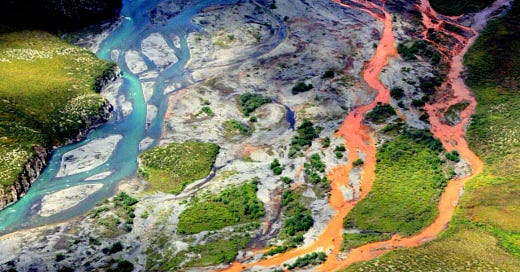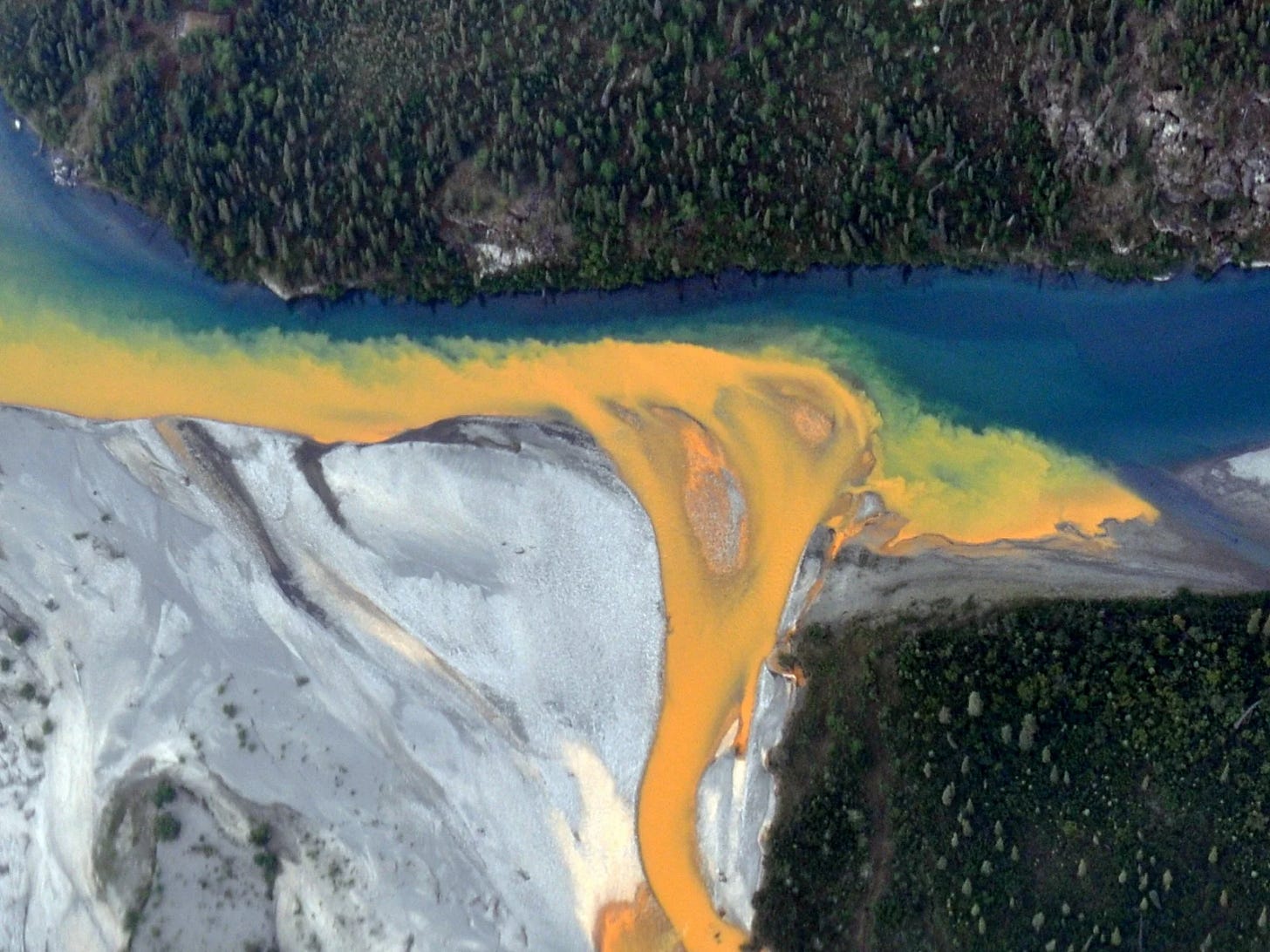I was playing a game at our family dinner table. We each had to close our eyes and someone else would give us a word. We would have to say the first 5 words that came to our mind in 6 seconds (the others would be judge of whether the five words each of us said were relevant or not; needless to say, we all fought hard to declare each other’s words irrelevant).
When it was my turn to close my eyes, I was given the word ‘Alaska’. Out came - cold, snow, bear, cruise and white. Thankfully, I passed the round without much noise and debate. Not too long after dinner as I was scanning my email, I saw the words ‘Alaska turns orange’ on my daily news feed.
If you are a new reader to ‘The Lighter Side’, welcome! Every week, I find one interesting news story and can’t wait to share it with my fellow readers. I delve into a little detail, adding a little bit of science / riddles / stories along the way. Hope you enjoy this week’s newsletter on ‘Alaska’s rivers turning orange’. Also, I host a kids podcast on current affairs. If you are one for stories and happy conversations, listen to them by clicking on the link below.
Tell me a little about the rivers of Alaska
Alaska, as you may have heard, is home to the cold Arctic snow, many varieties of bears, whales, crude oil and thousands of rivers. It is home to more than 12,000 rivers (not counting the tiny little tributaries, which themselves number to many thousands). People living in mainland USA like to vacation in Alaska. They usually climb aboard a cruise ship, pose for photos with glaciers in the background and wave a ‘Hi’ to bears that look curiously at these ships from a distance.
The rivers in Alaska are GIGANTIC. Yukon is the longest river in Alaska and is amongst the top 25 longest rivers in the world. All that snow sitting in the Arctic tend to get a little lean every once in a while and melt. While it does rain in Alaska, the massive rivers in this region are mainly snow-fed. The melting glaciers feed them all year long. Here’s a beautiful snapshot of the Yukon river in Alaska.

It is common for tourists to rent a boat and paddle down the river. Some stretches are gentle and you might meet a bear that comes to feed (not humans if you are lucky, but the fish).

What’s all this about rivers turning orange?
Snow, as we have seen, is usually white in colour. The rivers, as we have seen from the photos above, are often clear blue or bluish in tinge. The Alaskan rivers have stayed this way for nearly 2 million years. Or so, until about a decade ago. Here’s how some of the rivers look now.
On the left, you can still see the clear blue of some of the rivers and on the right, they are bright orange! A group of researchers from the National Park Service, the University of California at Davis and the US Geological Survey got together. They visited 75 locations along the rivers of Alaska’s Brooks Range (it’s a mountain range in the state). They studied what was going on with the water and if it was just a lot of mud and soil mixed in the water that was giving the river its orange colour. What do you think?
Before we proceed with our story, we need to decode a little word called ‘permafrost’.
What’s Permafrost?
This is ground that remains completely frozen (below 0°C) for more than two years straight. You can find permafrost regions that have remained frozen for thousands of years near the North and South Poles.
Owing to climate change or global warming, as temperatures have begun to rise, the ground beneath the glaciers have started to melt. Permafrost has so far kept many objects frozen (including dead mammoths and long dead sabre-tooth tigers). I am not sure if Alaska has any of these dead creatures buried deep beneath, but it certainly has a lot of metals beneath its ground. So, with permafrost thawing (i.e. ground warming), several of these metals are beginning to be released from the ground and leech into the glaciers / snow around them. This snow in turn, melts and flows into rivers.
Researchers studied 75 locations along different Alaskan rivers and found that the water contained highly acidic metals, including iron, zinc, copper and lead. Many of these metals react with oxygen. These in turn, give the water its orange-ish hue. For example, ferrous oxide and lead oxide are orange in colour. Copper(I) oxide becomes the reddish mineral cuprite.
Science trivia - tell me more about the acidity in these rivers
Acidity is measured by the pH level. Any value below 7 is acidic and above 7 is alkaline. For example, the cow’s milk that we drink is slightly acidic and has a pH of 6.5 - 6.7. But, if you leave the same cow’s milk in hot weather, it will go sour. It’s pH value declines to 4.5. Try bringing the sour milk close to your face and I guarantee you will run out of the room holding your nose.
In these rivers of Alaska, the researchers found that discoloured waters have a pH of 2.3 (imagine how they must stink!).
Normally, the clear blue rivers of Alaska have a pH of 8.
So what if there are metals in the Alaskan rivers?
Fish and other water creatures cannot survive in water that is highly acidic in nature. For one, the fish species living in these waters will perish. Also, aquatic species that live elsewhere and often pass through these stretches as part of their migration to spawn and give birth, will no longer attempt to go anywhere near these orange stretches. If they can’t find any alternate routes, they may not be able to give birth to their young ones. Which is to say, these aquatic species native to these areas might begin to die a fast death.
The human communities living in Alaska are also at risk (I add this point because humans tend to understand their misery best, when it affects them). People living near these rivers depend on them for drinking water, and now have to look elsewhere. They live so remotely that you can well imagine how far they would need to travel to get any clean drinking water.
I am annoyed at reading how mankind is destroying our planet. Give me some riddles and trivia to cheer me up.
Here are two pieces of trivia and one riddle for you.
a) Can you see the orange rivers from space?
Yes. For two reasons: (a) the rivers in Alaska are gigantic; (b) they have developed a thick yellow / red / orange in colour. The photo below is that of the Kutuk river, taken from space. It almost looks like orange paint spilling onto blue on an artist’s canvas.
b) Can you see the Northern Lights in Alaska?
Yes. Pretty much around the year, or nearly 250 days a year. If you plan to visit the region, you will most likely see the spectacular Aurora Borealis through nearly 8 months of the year.
c) Riddle for you - What’s brown in colour, eats both fish and plants and can outrun most humans visiting Alaska? The answer is a hyphenated word with seven letters first and four letters next. Scroll to the end to find the answer.
Podcasts to listen to from our ‘Fake or Real’ series
Newspaper headlines often make loud claims about fitness, health and diet. How much of this is backed by research? Have the facts been verified? As part of our Fake or Real podcast series, we take popular newspaper headlines and our young co-hosts check if they are real or fake!
(a) Headline 1: 'Himalayan pink salt is healthier than iodized powdered white salt'. Listen to the episode to find out if this is for real.
(b) Headline 2: Younger siblings are funnier than their older counterparts. Find out if this is fake or real.
Planning a trip with your family to Alaska? A guest on our sister podcast channel ‘Misadventures of a Sneaker’ traveled there a couple of years ago and shared his adventures on this trip. He also gave lots of tips on how to plan your itinerary for a trip there (especially if you are going there with your family).
Answer to the riddle - What’s brown in colour, eats both fish and plants and can outrun most humans visiting Alaska? The answer is the GRIZZLY-BEAR.
Source articles I referred to for the news on Alaskan rivers
Study published in the Nature magazine
Video on USA Today





